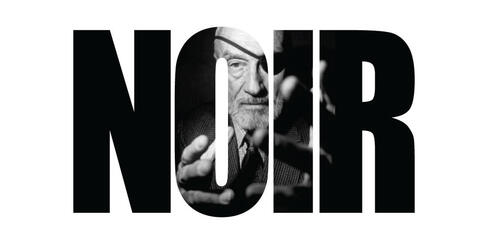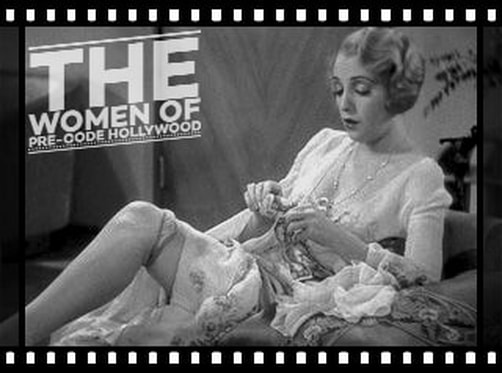The 1920s was a decade of change. It was the era of the eighteenth and nineteenth Amendments being passed. The former was Prohibition - the forbidding the manufacture or sale of “intoxicating liquors” - the latter was allowing women the right to vote. For leisure, families gathered around the radio to listen to news, music and comedy shows.
When you weren't gathering around the radio, perhaps you were taking in a movie at one of several "Picture Palaces" - these lavish theaters often had a full orchestral accompaniment complementing the silent films they were running. Devoid of synchronized dialog, these films relied on a pantomime of over-the-top body language and facial expressions to convey its storyline.
The 1920s produced a number a major film stars including: Greta Garbo, Gloria Swanson, Ramon Novarro, Pola Negri, Rudolph Valentino, Mary Pickford, Lillian Gish, among many others.
Greta Garbo came to Hollywood in 1925 at the behest of Louis B. Mayer (MGM). The 3rd film she made at MGM that catapulted her to stardom was A Woman of Affairs (1928). One of 23 films featured on this site of her iconic portrayal of world-weary, strong-willed heroines.
DRAMA FILMS OF THE 1920s
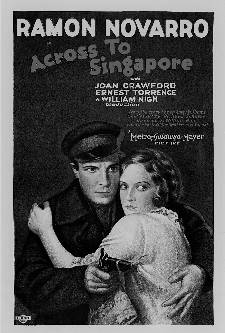 ACROSS TO SINGAPORE (1928)
ACROSS TO SINGAPORE (1928) (70 Min.) Genre: 1920 DRAMA, Transfer Quality: A
Across to Singapore was the second screen version of Ben Ames Williams' All the Brothers Were Valiant, first filmed in 1923, and later remade in 1953. The plot is motivated by the deadly rivalry between two seafaring brothers, virtuous deckhand Joel Shore (Ramon Novarro) and wicked Captain Mark Shore (Ernest Torrence). Forced into a marriage with Mark, Priscilla Crowninshield (Joan Crawford) tries to be loyal to her husband but falls in love with Joel instead. Things reach a fever pitch when mutinous first mate Finch (James Mason) strands Shore in Singapore and takes Joel and Priscilla prisoner. Mark catches up with his ship and kills the mutineers, but when he realizes that his wife is now deeply in love with his brother, he considerately sacrifices his own life in the climactic melee. — Hal Erickson
Starring: Ramon Novarro, Joan Crawford, Ernest Torrence, Frank Currier, Anna May Wong | Directed by: William Nigh
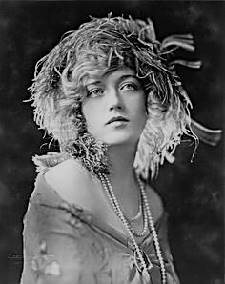 BEAUTIFUL REBEL, THE (1924)
BEAUTIFUL REBEL, THE (1924) (140 Min.) Genre: 1920 DRAMA, Transfer Quality: B
Newspaper magnate and movie producer William Randolph Hearst created this massive epic about the American Revolution to showcase the talents of his mistress Marion Davies. The results were far better than anyone could have imagined, given these circumstances; both film content and Marion were artistic successes. The story literally covers the whole Revolution and has Davies' character, Janice Meredith, playing a key part — in Hearst's world, Marion/Janice is the one ultimately responsible for sending Paul Revere on his famous ride! However, America's fight for freedom (including the Boston tea party, Valley Forge, etc.) shares space with the picture's love story: Janice, who comes from a family of wealthy Tory sympathizers is in love with a servant named Charles Fownes (Harrison Ford). Fownes, of course, is a rebel and joins George Washington's (Joseph Kilgour) staff. Their love survives through many political and war intrigues until the day Fownes insists that Janice cut ties with all British associates, including her father (Maclyn Arbuckle). She refuses and goes home to marry Philemon Hennion (Olin Howland), but Fownes leads a rebel raid that thwarts the wedding. The Meredith lands are taken by the rebels and Hennion is arrested for his work with the British. Finally, as the Revolution nears its triumphant end, Janice and Fownes wind up together. W.C. Fields, as a British sergeant, provides a small bit of comic relief from all this drama. While Janice Meredith received honestly enthusiastic reviews (not just from the Hearst papers), its negative cost of nearly a million dollars — a fortune in those days — prohibited it from making a profit.
Starring: Marion Davies, Harrison Ford, Maclyn Arbuckle, Spencer Charters | Directed by: Walter Futter, E. Mason Hopper
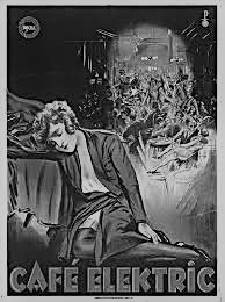 CAFÉ ELEKTRIC (1927)
CAFÉ ELEKTRIC (1927) (78 Min.) Genre: 1920 DRAMA, Transfer Quality: B
Only one incomplete print of this film exists. The end of the movie is believed to be lost. Cafe Electric is one of many German silent films Marlene Dietrich played in before her "discovery" by Josef von Sternberg in which she was cast as Lola Lola in the Blue Angel and began her American film career. The early scenes of Berlin in the 1920's are notable for a glimpse of the times and that they were shot on location. The plot is moralistic but not without intrigue. It's also very interesting to see a young Dietrich before the meticulous attention to her glamorous look in American films. ICafe Electric is a must see for those interested in silent films of the '20's and especially Marlene Dietrich fans.
Starring: Willi Forst, Marlene Dietrich, Fritz Alberti, Anny Coty | Directed by: Gustav Ucicky
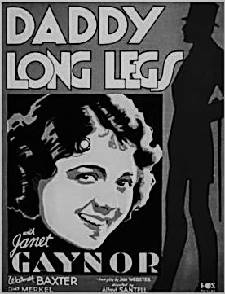 DADDY LONG LEGS (1919)
DADDY LONG LEGS (1919) (7-Reels Min.) Genre: 1920 DRAMA, Transfer Quality: A
This first of several cinematic adaptations of the Jean Webster play Daddy Long Legs stars "America's Sweetheart," Mary Pickford. The oldest and cutest of a group of orphans, Pickford is provided with funds for her education and well-being by a mysterious benefactor, whom she knows only as "Daddy Long Legs" because of the spider-like shadow he casts on the orphanage steps. Upon reaching a marriageable age, Pickford falls in love with handsome Mahlon Hamilton, never dreaming that he and Daddy Long Legs are one in the same. When he proposes marriage, she properly announces that she'll need her guardian's consent, and thus the stage is set for the film's conclusion. Like several of Mary Pickford's best silent films, Daddy Long Legs was remade in the talkie era by Shirley Temple (as 1935's Curly Top). — Hal Erickson
Starring: Mary Pickford, Joan Marsh, Fay Lemport, Lillian Langdon | Directed by: Marshall Neilan
 DAUGHTER OF THE NIGHT (1920)
DAUGHTER OF THE NIGHT (1920) (55 Min.) Genre: 1920 DRAMA, Transfer Quality: B
This German melodrama starring blonde bombshell Lee Parry is notable only for containing an early appearance of future horror icon Bela Lugosi. Lugosi plays a French count who falls for a Russian cabaret singer turned spy for the revolutionary forces (Miss Parry). Happily, Bela's recently jilted girlfriend (Violette Napierska) just happens to be an undercover agent for the opposing forces. The film, whose German title, Der Tanz Auf Dem Vulkan, translates into something like "Dancing on a Vulcano ", was originally released in two episodes: "Sybil Young" and "Der Tod des Grossfursten" ("The Death of the Grand Duke").
Starring: Lee Parry, Bela Lugosi, Violetta Napierska, Robert Scholz | Directed by: Richard Eichberg
 DOCKS OF NEW YORK, THE (1928)
DOCKS OF NEW YORK, THE (1928) (75 Min.) Genre: 1920 DRAMA, Transfer Quality: B
The smokily erotic ambience of Josef Von Sternberg's silent Docks of New York is best appreciated on a big theatrical screen—but only if the available print is at the very least second-generation. George Bancroft plays a two-fisted ship's stoker on shore leave. He saves Betty Compson from committing suicide; though the girl displays little gratitude, the inebriated Bancroft impulsively marries her. After he sobers up, Bancroft is prepared to set sail and leave his new wife waiting for him...perhaps forever. The story is secondary to the virtuosity of the direction and camerawork (one scene is framed in the eye of a needle!) Considered by many to be Von Sternberg's greatest film, Docks of New York is a prime example of the silent cinema at its zenith.
Starring: George Bancroft, Betty Compson, Olga Baclanova, Clyde Cook | Directed by: Josef von Sternberg
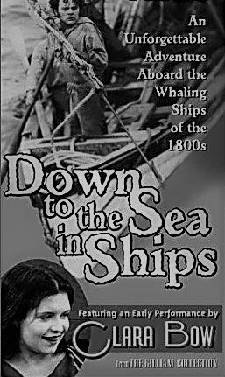 DOWN TO THE SEA IN SHIPS (1923)
DOWN TO THE SEA IN SHIPS (1923) (83 Min.) Genre: 1920 DRAMA, Transfer Quality: A
This whaling drama is most famous as the screen debut of Clara Bow (Bow had actually made one previous film, Beyond the Rainbow, but her scenes wound up on the cutting-room floor). Besides that, it is also solid entertainment, offering both the best (documentary-like scenes of a whale being gutted) and the worst (some scenery-devouring histrionics) that silent film had to offer. It's a period piece, taking place in a seaside town of the mid-1800s. Charles Morgan (William Walcott) is a Quaker who owns a successful whaling business. He has lost his son to the sea and is raising his tomboyish granddaughter, Dot (Bow). Morgan wants his own daughter, Patience (Marguerite Courtot) — Dot's aunt — to marry a Quaker whaler. Patience, however, is in love with Allan Dexter (Raymond McKee), the non-Quaker boy next door, who has just returned from school. Meanwhile, Jake Finner (Pat Hartigan) and Samuel Siggs (J. Thornton Baston) are plotting to get Morgan's fortune. Siggs, disguised as a Quaker, goes to work for Morgan and convinces him that he should marry Patience. Dexter, however, loves Patience so much he is willing to change both his religion and his profession to win her. He winds up on a whaling ship, captained by the wicked Finner, gets involved in the subsequent mutiny, and harpoons his first whale. Dot has stowed away on the ship because she has a crush on one of the boys (James Turfler) who is on the crew. Dexter returns home just in time to prevent Patience from marrying Siggs. Although Courtot spends most of her time merely looking pretty, there's a palpable chemistry between her and McKee — they actually fell in love in real life and married. With her vivacious personality and natural acting, Bow (who looks far younger than her 16 years) steals almost every scene she is in. She obviously had star quality, even this early in her career — something that did not go unnoticed amongst critics and filmgoers.
Starring: Clara Bow, Raymond McKee, William Walcott, William Cavanaugh | Directed by: Elmer Clifton
 ETERNAL LOVE (1929)
ETERNAL LOVE (1929) (9-Reels Min.) Genre: 1920 DRAMA, Transfer Quality: A
Eternal Love was the last silent film of star John Barrymore and director Ernst Lubitsch; thereafter, both men would concentrate exclusively on talkies. Based on Der Konig der Bernina, a novel by Jakob Christopher Beer, the story is set in the Swiss Alps in 1812. Both forced into loveless marriages, sweethearts Marcus (John Barrymore) and Ciglia (Camilla Horn) continue to carry on a clandestine romance. When Marcus is falsely accused of murdering Ciglia's husband, the two lovers escape into the Alps, with the angry villagers close at their heels. With no other recourse, Marcus and Ciglia elect to commit suicide, walking hand in hand into the path of an avalanche. Filmed on location in the Canadian Rockies, Eternal Love was a most uncharacteristic venture into doom-and-gloom for director Lubitsch, who was never quite so dour again. — Hal Erickson
Starring: John Barrymore, Camilla Horn, Victor Varconi, Hobart Bosworth | Directed by: Ernst Lubitsch
 FLESH AND THE DEVIL (1927)
FLESH AND THE DEVIL (1927) (109 Min.) Genre: 1920 DRAMA, Transfer Quality: A
A bulky, verbose novel by Herman Suderman was the source for the exquisitely silent Flesh and the Devil. On leave from the Austrian army, lifelong friends John Gilbert and Lars Hanson return to their loving families. At a reception in Hanson's honor, Gilbert makes the acquaintance of the hauntingly beautiful Greta Garbo, whom he'd previously glimpsed for a few fleeting seconds at the railway depot. Those few seconds were enough to thoroughly captivate Gilbert, thus paving the way for a feverish sexual liaison with Garbo. Gilbert is shocked to discover that Garbo is married to aristocrat Marc MacDermott, who challenges Gilbert to a duel—on the proviso that the "official" reason for their argument is a disagreement at cards, so that McDermott will suffer no disgrace. Gilbert kills the husband on the field of honor; as punishment for his unmilitary conduct, he is "invited" to accept a post in Africa. Honoring his promise to the late McDermott, Gilbert reveals his love of Garbo to no one, not even his dearest friend Hanson. As he departs for his five-year exile, Gilbert asks Hanson to look after the "bereaved" Garbo. Pardoned after three years, Gilbert returns home, only to discover that Garbo has remarried—to Hanson. Minister George Fawcett, evidently the only person to know of Gilbert's tryst with Garbo, advises Gilbert to give up his friendship with Hanson so as to avoid the temptation of cuckolding his best friend. But when Hanson falls seriously ill, Garbo begs Gilbert to renew the friendship. He does so, not suspecting that Garbo merely wants to trap him in her web again. Gilbert is caught in a compromising position by the distraught Hanson; he regretfully challenges Gilbert to a duel, to be fought on their favorite childhood playing site, "The Island of Friendship". As Hanson nervously aims his weapon at the repentant, unresisting Gilbert, he realizes that he can't go through with the duel. The two friends embrace, begging one another's forgiveness...while Garbo, who has belatedly headed across the frozen lake to prevent the duel, comes to an icy end. While the overly intense "male bonding" between John Gilbert and Lars Hanson tends to evoke knowing chuckles when seen today, Flesh and the Devil otherwise holds up quite well. Clarence Brown's innovative directorial touches still seem fresh after years of imitation by lesser talents. Ostensibly a John Gilbert vehicle (he receives sole over-the-title billing), Flesh is utterly dominated through sheer force of personality by the divine Garbo; in anyone else's hands, her enigmatic, impulse-driven temptress would have been just another cardboard vixen. — Hal Erickson
Starring: Greta Garbo, John Gilbert, Lars Hanson, Barbara Kent | Directed by: Clarence Brown
 HER PRIVATE AFFAIR (1929)
HER PRIVATE AFFAIR (1929) (70 Min.) Genre: 1920 DRAMA, Transfer Quality: A
In her second film, Broadway actress Ann Harding plays the vacationing wife of a judge who finds herself blackmailed by a notorious gigolo. Leaving her husband after a quarrel, Vera Kessler (Harding) dallies rather innocently with Arnold Hartman (Lawford Davidson). Hartman, however, engages in a bit of blackmail and when Vera confronts him, a scuffle breaks out. In the heat of the moment, Vera picks up a gun and the gigolo ends up dead. The butler is arrested for the crime, and although the poor man is acquitted in court, Vera's guilt drives her to leave her husband. But the good judge (Harry Bannister) overhears his wife confessing the truth to the rather confused factotum and forgives her. Despite the mediocre plot and an overstuffed production, Her Private Affair proved a huge box-office success and boded well for Harding's future in Hollywood. Harry Bannister was "Mr. Harding" in private life at the time.
Starring: Ann Harding, Harry Bannister, John Loder, Kay Hammond, Arthur Hoyt | Directed by: Paul Stein
 KISS, THE (1929)
KISS, THE (1929) (89 Min.) Genre: 1920 DRAMA, Transfer Quality: A
MGM's paranoid fear of audience reaction to Greta Garbo's speaking voice must have been the only reason for this plodding courtroom melodrama to have been made as a silent. Released with a synchronized score and two important sound effects, The Kiss would prove to be Garbo's, and Metro's, final silent feature film. Happily, Belgian director Jacques Feyder used both the pantomime format and the aforementioned sound effects — a gunshot and the incessant ringing of a telephone — to optimum effect. When ulcer-plagued husband Anders Randolf returns unexpectedly in the middle of a smooch between his wife and 18-year-old Lew Ayres, he naturally jumps to the wrong conclusion. But the kiss is in reality merely Garbo's firm goodbye to an overly anxious admirer. Randolf and Ayres fight, Garbo vainly attempts to reason with her husband, a closed door shields the action from the viewer, and only a muffled shot is heard (yes, heard). Then the telephone rings: It is Ayres' father (Holmes Herbert) wondering why his appointment, Randolf, never showed. To shield the boy, Garbo takes the blame for the killing (she actually did do it but only to save Ayres' life) and is defended in court by the real love of her life, Conrad Nagel. Hans Kraly's screenplay is a bit heavyhanded and certainly nothing special, but Garbo's luminous presence almost saves the film from the doldrums. She plays the kind of society wife who lounges about in Art Deco elegance, keeping a stack of eight-by-ten glossies at the ready to hand out to young admirers like Ayres. It is all completely artificial of course, but Garbo somehow makes it believable. The supporting cast is what you expect: Ayres, handsome and impossibly young, Randolf, all bombast and pomposity, and Nagel, his usual dull self. For now obscure reasons, Conrad Nagel was highly regarded at the time and was by far Hollywood's busiest leading man at the changeover to sound. Garbo enjoyed working with Feyder, who went on to guide her through the German-language version of Anna Christie in 1930; and she was always more relaxed on and offscreen when other Scandinavians were around, in this case the Danish-born Randolf. As the near future would reveal, neither Garbo nor Metro had anything to worry about regarding the diva's accent and in February of 1930, the studio could at long last proudly proclaim that Garbo talks. She was the last major star to do so with the possible exception of Charles Chaplin. — Hans J. Wollstein
Starring: Greta Garbo, Conrad Nagel, Anders Randolf, Holmes Herbert, Lew Ayres | Directed by: Jacques Feyder
 LADY OF THE NIGHT (1925)
LADY OF THE NIGHT (1925) (62 Min.) Genre: 1920 DRAMA, Transfer Quality: A
Norma Shearer was very much an up-and-coming young actress when she played a dual role in this MGM drama. Molly, a girl of the streets (Shearer), is getting out of reform school at the same time that Florence (also Shearer) is graduating from a finishing school. While at a dance hall, Molly has a run-in with a lusty young man, but she is rescued by David, a young inventor whose workshop is nearby (Malcolm McGregor). As a result, Molly becomes David's friend, and she is the one who insists that David sell his invention — a safecracking device — to the banking industry instead of to a gang of crooks who have offered him a percentage of their take. Through the bankers, David meets Florence, and soon both she and Molly are in love with him. David believes that Florence is the right girl for him, but when she discovers the existence of Molly, she insists that Molly was first. Molly, realizing that Florence would be a better match for David, returns to Chunky, a young man who, like her, comes from the street (George K. Arthur). Shearer's stand-in for this picture was a very ambitious young starlet by the name of Lucille LeSueur — better known later on as Joan Crawford.
Starring: Norma Shearer, Malcolm McGregor, George K. Arthur, Fred Esmelton | Directed by: Monta Bell
 LAST OF MRS. CHEYNEY, THE (1929)
LAST OF MRS. CHEYNEY, THE (1929) (94 Min.) Genre: 1920 DRAMA, Transfer Quality: A
This early talkie was based on Frederick Lonsdale's successful Broadway play. Fay Cheyney (Norma Shearer) is a cunning jewel thief who impersonates a wealthy widow as she travels to Monte Carlo, planning on stealing a fortune in pearls from one Mrs. Webley (Maude Turner Gordon); Fay's henchmen also travel with her, posing as her servants as they help her plan the heist. However, Fay has a change of plans when she meets Lord Arthur Dilling (Basil Rathbone), who is wealthy, handsome, titled, and Mrs. Webley's nephew. Fay and Arthur soon become infatuated with each other, and Fay puts her plans on hold as she begins to travel in his privileged social circle; however, when she's invited to a private soiree at Mrs. Webley's mansion, the temptation is too great, and she attempts to steal the pearls. However, she's caught in the act by Arthur, who offers to make a deal — if Fay will sleep with him, he won't tell Mrs. Webley that she's a fraud. Fay is taken aback by this affront to her honor, and instead confesses to Mrs. Webley and her assembled guests that she is not who she has purported to be. Shocked, the assembled socialites decide to turn her in to the police, until Lord Elton (Herbert Bunston) admits that he wrote Fay an indiscreet letter that had incriminating information about many of their friends. With Fay in a position to blackmail her blue-blooded acquaintances, they attempt to buy her silence, but Fay proves that despite her criminal history, she has her principles. The Last of Mrs. Cheyney was remade in 1937 (with Joan Crawford in the lead), and again in 1951 as The Law and the Lady, starring Greer Garson. A German version also appeared in 1961. — Mark Deming
Starring: Norma Shearer, Basil Rathbone, George Barraud, Herbert Bunston | Directed by: Sidney A. Franklin
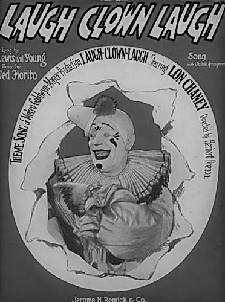 LAUGH CLOWN LAUGH (1928)
LAUGH CLOWN LAUGH (1928) (74 Min.) Genre: 1920 DRAMA, Transfer Quality: A
Fifteen-year-old Loretta Young is 45-year-old Lon Chaney's winsome leading lady in Laugh, Clown, Laugh. Based on the war-horse stage piece by David Belasco and Tom Cushing, the film casts Chaney as (what else?) an aging circus clown, who adopts an orphaned girl and falls in love with her when she grows up. Alas-and not surprisingly-the girl loves another, prompting Chaney to perform a suicidal circus stunt, freeing her to marry the man she truly cares about (Nils Asther). Chaney had been here before, having played a similar role opposite Norma Shearer in 1924's He Who Gets Slapped. Though widely touted as Loretta Young's film debut, she had actually made earlier appearances with her sisters as a child extra. A silent film, Laugh Clown Laugh was released with a musical sound track, which highlighted the hit title song. — Hal Erickson
Starring: Lon Chaney, Bernard Siegel, Loretta Young, Cissy Fitzgerald, Nils Asther | Directed by: Herbert Brenon
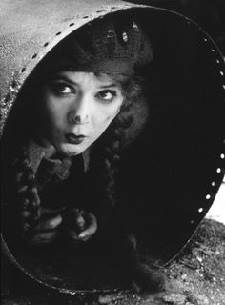 LITTLE ANNIE ROONEY (1925)
LITTLE ANNIE ROONEY (1925) (94 Min.) Genre: 1920 DRAMA, Transfer Quality: A
Thirty-two year old Mary Pickford returned to form as America's Sweetheart as Little Annie Rooney, a tough teenager from the streets who gets into mischief with her little gang of ruffians. She has a boyfriend, Joe Kelly (William Haines), whom she is sweet on. But when her father (Walter James) is killed, her brother Tim (Gordon Griffith) thinks that Joe is the murderer. Tim shoots Joe with his father's gun, but Annie, convinced of Joe's innocence, gives him a blood transfusion and saves his life. She then organizes her gang of street kids to search for the real killer of her father. — Paul Brenner
Starring: Mary Pickford, William Haines, Walter James, Gordon Griffith | Directed by: William Beaudine
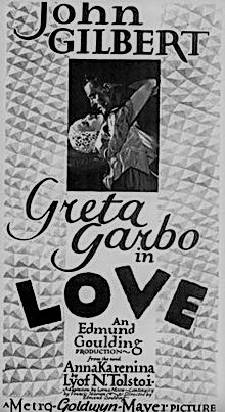 LOVE (1927)
LOVE (1927) (82 Min.) Genre: 1920 DRAMA, Transfer Quality: A
This MGM-ized adaptation of Leo Tolstoy's Anna Karenina was originally titled Heat but was changed to Love when someone at the studio pointed out the possible implications of having the opening title read "John Gilbert and Greta Garbo in Heat." Heavily updated and revised, the film bore scant relation to the Tolstoy original, save for the fact that heroine Anna Karenina (Greta Garbo) is threatened with ruin by her aristocratic husband Karenin (Brandon Hurst) when she falls in love with dashing Russian officer Vronsky (John Gilbert). The story goes that MGM head Irving Thalberg purchased the novel without reading it, only to discover to his chagrin that Tolstoy's heroine "solves" her problems by throwing herself under a moving train. While it's hardly likely that the well-read Thalberg would not be aware of the book's outcome, it is true that Love was shipped out with two different endings. The original tragic denouement was retained for the European prints, while a ludicrous happy ending — in which the widowed Anna is permitted to marry Vronsky after a respectable five-year period — was tacked on in America. Nor was this the only change: when it became obvious that the film's original Karenin, Lionel Barrymore, was stealing focus from Garbo, Barrymore was replaced by the less charismatic Brandon Hurst. As a Tolstoy adaptation, Love was a flop; as a lush, quasi-erotic Gilbert-Garbo vehicle, it was a hit. Nine years later, Garbo would co-star with Fredric March in a more faithful cinemadaptation of Anna Karenina, with the doleful ending intact. — Hal Erickson
Starring: Greta Garbo, John Gilbert, George Fawcett, Brandon Hurst | Directed by: Edmund Goulding
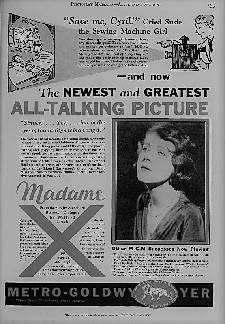 MADAME X (1929)
MADAME X (1929) (95 Min.) Genre: 1920 DRAMA, Transfer Quality: A
Alexandre Brisson's weepy 1906 play had already been filmed three times when the 1929 talkie Madame X made its debut. Ruth Chatterton stars as a low-born wife of a socialite, whose aristocratic in-laws kick her out when she gives birth to a baby boy of dubious parentage. The boy, who has been led to believe his mother is dead, grows up to become a renowned attorney (Raymond Hackett). Mama Chatterton takes to the streets, but proudly monitors her son's progress from afar. When Chatterton is accused of murder, her defense attorney is none other than her son. She refuses to tell him the truth about their relationship, even though that information may make the difference between execution and exoneration. Madame X would be remade three more times over the next five decades; to avoid confusion with these later versions, the 1929 Madame X has been retitled Absinthe for its TV showings. — Hal Erickson
Starring: Ruth Chatterton, Lewis Stone, Raymond Hackett, John P. Edington | Directed by: Lionel Barrymore
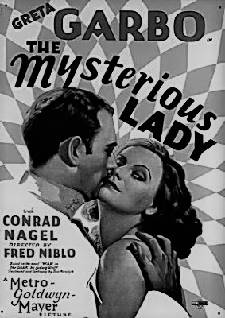 MYSTERIOUS LADY (1928)
MYSTERIOUS LADY (1928) (83 Min.) Genre: 1920 DRAMA, Transfer Quality: A
Based on a lugubrious novel by Ludwig Wolff, The Mysterious Lady is a romance/espionage tailored to the talents of Greta Garbo. The divine Miss G plays an alluring Russian spy, directly answerable to satanic-featured general Gustav von Seyffertitz. While she's accustomed to fomenting suicides and apoplexy amongst her male victims, Garbo cannot help but become romantically involved with Austrian-officer Conrad Nagel. Forced to choose between her love of Russia and her love for Nagel, Garbo decides upon the latter—meaning that there's a bullet in the future for vonSeyfertitz. For all its MGM gloss, Mysterious Lady would be just so much borscht without the ethereal presence of its female star. — Hal Erickson
Starring: Greta Garbo, Conrad Nagel, Gustav von Seyffertitz, Edward Connelly | Directed by: Fred Niblo
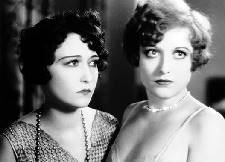 OUR DANCING DAUGHTERS (1928)
OUR DANCING DAUGHTERS (1928) (83 Min.) Genre: 1920 DRAMA, Transfer Quality: A
Even those who can't recall the plot of the silent Our Dancing Daughters (and there admittedly isn't much to remember) can never forget the indelible images of Joan Crawford tearing loose with one Charleston after another. Since everyone in the film is rich, the wild parties that dominate Our Dancing Daughters are played out in the biggest mansions this side of Windsor castle. Jazz-baby Crawford is actually a good girl despite her hedonistic lifestyle. She wants to marry young millionaire Johnny Mack Brown, but he is tricked into marriage by deceitful Anita Page. After drinking herself blotto at a party, Anita brags about her subterfuge, then conveniently tumbles down a long flight of stairs to her death ("Poor little rich girl" is the general consensus of opinion amongst the many servants, though few in the audience are shedding any tears). Thus, Crawford is able at last to link up with Brown, presumably to live happily ever after. Released with synchronized music and sound effects, Our Dancing Daughters manages to convey the "noise" of the Roaring '20s without sound, relying instead on inserted shots of art-deco statuary and the bubbling-over performance of Joan Crawford in the role that made her a star. Crawford was reunited with her Dancing Daughters co-stars Anita Page and Dorothy Sebastian in two follow-up films (not sequels), Our Modern Maidens (1929) and Our Blushing Brides (1930). — Hal Erickson
Starring: Joan Crawford, Johnny Mack Brown, Dorothy Sebastian, Nils Asther | Directed by: Harry Beaumont
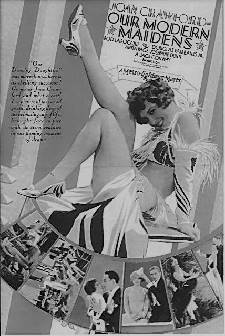 OUR MODERN MAIDENS (1929)
OUR MODERN MAIDENS (1929) (75 Min.) Genre: 1920 DRAMA, Transfer Quality: B
This follow-up to MGM's 1928 hit Our Dancing Daughters reunites the female stars of the earlier film: Joan Crawford (in her last silent film) and Anita Page. Crawford is engaged to Douglas Fairbanks Jr. (her real-life husband at the time), but both she and her fiance fall in love with other people before the wedding takes place. Fairbanks Jr. renders Anita Page pregnant, but goes through with his wedding to Crawford all the same. Meanwhile, Crawford romances diplomat Rod La Rocque, partly in the hopes of advancing Doug's career, but mostly out of boredom. At any other studio, the romantic intrigues of Our Modern Maidens would be played out in small living rooms and cozy apartment houses. But MGM had a positive mania for placing its stars in the biggest, draftiest mansions possible, then dressing them to the nines in expensive costumes designed by the studio's own fashion arbiter Adrian. Our Modern Maidens proved successful, spawning a third in this loosely constructed series, Our Blushing Brides (one contemporary critic wondered aloud if the next film would be Our Dizzy Divorcees).
Starring: Joan Crawford, Rod La Rocque, Douglas Fairbanks, Jr., Anita Page | Directed by: Jack Conway
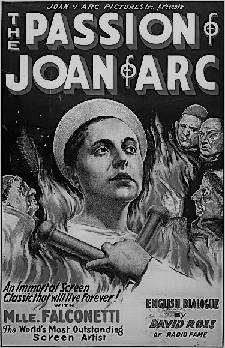 PASSION OF JOAN OF ARK, THE (1928)
PASSION OF JOAN OF ARK, THE (1928) (82 Min.) Genre: 1920 DRAMA, Transfer Quality: A
The Passion of Joan of Arc (La passion de Jeanne d'Arc) is widely regarded as Danish director Carl Theodor Dreyer's finest achievement and one of the greatest films of all time. Dreyer recreates the trial and execution of St. Joan with near-documentary authenticity, as if one were present at the actual 15th century event and both defendant and accusers were the genuine article. The director's use of huge, probing closeups—detailing every pockmark and even the saliva at the sides of the mouths—adds a shocking immediacy which makes it hard to believe that this film is nearly seventy years old. As Joan, Maria Falconetti (in her only film) transcends mere praise. Passion of Joan of Arc is a silent film, but the original transcripts of Joan's trial are brilliantly conveyed by the pantomime of the actors. The film's title is supremely double-edged: Joan's "passion" is shown to be as erotic as it is spiritual. — Hal Erickson
Starring: Renée Maria Falconetti, Eugène Silvain, Antonin Artaud, Maurice Schutz | Directed by: Carl Theodor Dreyer
 QUEEN KELLY (1929)
QUEEN KELLY (1929) (113 Min.) Genre: 1920 DRAMA, Transfer Quality: A
Though filmmaker Erich Von Stroheim's notorious profligacy had made him virtually unhirable in the US by 1929, screen-star Gloria Swanson still had faith in him. She poured a great deal of her own money in Von Stroheim's last silent film, Queen Kelly, and agreed to play the leading role to insure box-office success. When production began, Stroheim had not quite completed his script: all he had was the premise of a young Irish convent girl named Kitty Kelly (Gloria Swanson) being seduced by a German nobleman (Walter Byron) who was slated to marry the mad Queen (Seena Owen) of a tiny European principality. Brandishing a whip, the looney Queen drives the hapless Kitty from the palace. It was after shooting had started that Von Stroheim filled Swanson in on the rest of the plot: Kitty was to inherit all the worldly possessions of her aunt in German East Africa. Arriving to take charge of the estate, Kitty would learn that she was proud possessor of a string of brothels. Realizing that such a plot device would never get past the American censors, Swanson reacted in horror; she frantically called her money men in America and screamed "There's a madman in charge!" In the final release version of Queen Kelly, hastily completed by Swanson to recoup her losses and ultimately released in Europe, Kitty Kelly was forced into a marriage with brothel manager Tully Marshall, a tobacco-juiced stained degenerate. She ultimately returns to the nobleman who'd seduced her, is driven from the palace by Queen Owen, and commits suicide. This version contained dialogue sequences, and one musical interlude, sung by star Swanson. Despite its tawdry plot, Queen Kelly was beautifully photographed; its most famous shot, of Swanson praying in church, her face framed by flickering candles, was excerpted in the actress' much-later talkie Sunset Boulevard. The currently available restored version of Queen Kelly uses still pictures and explanatory titles to fill in the footage that has decomposed over the years.
Starring: Gloria Swanson, Seena Owen, Walter Byron, Madge Hunt, Erich Von Stroheim | Directed by: Erich Von Stroheim
 RED KIMONA, THE (1925)
RED KIMONA, THE (1925) (95 Min.) Genre: 1920 DRAMA, Transfer Quality: A
Three of Hollywood's more enterprising women created this sentimental treatise on sin and redemption: Mrs. Wallace Reid (the former actress Dorothy Davenport) produced and co-directed (with Walter Lang) and Dorothy Arzner's screenplay was based on a story by influential journalist Adela Rogers St. Johns. Priscilla Bonner starred as Gabrielle Darley, a real-life prostitute acquitted of murdering her procurer in 1917. Left in a New Orleans brothel by a bounder she mistakenly believed to be her fiancé, Gabrielle tracks down the man (Carl Miller) in a Los Angeles jewelry shop and kills him in cold blood. Immediately regretting her brutal act, Gabrielle is resigned to her fate when the jury surprisingly returns a verdict of not guilty. A free woman, Gabrielle wants to change her wayward life by becoming a nurse, but is instead invited to live in the palatial Wilshire Boulevard estate of Mrs. Fontaine (Virginia Pearson). With Freddy the chauffeur (Theodore Von Eltz) as her only ally, Gabrielle is cruelly paraded in front of Mrs. Fontaine's society friends, some of whom "have skipped a matinee to see you." Tiring of the notoriety quickly enough, Mrs. Fontaine arranges for an interview with the local hospital, knowing full well that Gabrielle's sordid past will prohibit her ever becoming a nurse. Distraught and penniless, Gabrielle returns to New Orleans, never realizing that Freddy is desperately searching for her. Chased by a pimp in the French Quarter, the exhausted girl runs out into the crowded street and is hit by a passing car. While recovering in the hospital, she fortuitously learns that the hospital needs personnel due to the devastating influenza epidemic and is soon employed as a cleaning woman. It is in the hospital where she is finally found by Freddy as he arrives with soldiers wounded overseas. Despite being shipped off to fight the war in Europe the following day, the former chauffeur vows to return and make Gabrielle his wife. A huge box-office success, The Red Kimono ended up nearly bankrupting Mrs. Reid when the real Gabrielle Darley sued for libel. In the end, Darley won a huge settlement that included the Beverly Hills home which Reid had shared with her late husband, 1910s matinee-idol Wallace Reid. — Hans J. Wollstein
Starring: Priscilla Bonner, George Siegmann, Tyrone Power, Sr, Virginia Pearson | Directed by: Walter Lang, Dorothy Davenport
 SCARLET LETTER, THE (1926)
SCARLET LETTER, THE (1926) (80 Min.) Genre: 1920 DRAMA, Transfer Quality: A
Based on the classic American novel by Nathaniel Hawthorne, this silent period drama was put together by star Lillian Gish, who was forced by Louis B. Mayer to assure religious groups that the still-controversial material would not offend their sensibilities. Gish plays heroine Hester Prynne, who becomes the object of affection for Reverend Arthur Dimmesdale (Lars Hanson) in 17th century colonial Massachusetts. Hester is in a loveless marriage to Roger Prynne (Henry B. Walthall), who has not followed her to the colonies. After a trip home to England, Dimmesdale returns to discover that Hester has given birth to his daughter, Pearl, and has been branded with a scarlet letter "A" (for adultery) that she is forced to wear visibly on her person at all times. Hester forces the tortured Dimmesdale to keep the secret of Pearl's paternity, and the sudden appearance of Roger, who was shipwrecked and kidnapped by natives, further complicates matters. — Karl Williams
Starring: Lillian Gish, Lars Hanson, Henry B. Walthall, Karl Dane | Directed by: Victor Seastrom
 SINGLE STANDARD, THE (1927)
SINGLE STANDARD, THE (1927) (73 Min.) Genre: 1920 DRAMA, Transfer Quality: A
Worried that Greta Garbo's rich, deep voice and thick Swedish accent would not record properly, MGM executives kept Garbo in silent pictures longer than any of the studio's other contractees. The star's penultimate silent effort (with music and sound effects added) was The Single Standard, based on a 1928 novel by Adela Rogers St. John. Weary of the "good old boy" mentality which dictates that men can flit from girl to girl while women are expected to remain faithful, San Francisco socialite Arden Stuart (Garbo) decides to adopt the "single standard" and play the field herself. She turns down a marriage proposal by millionaire Tommy Hewlett (Johnny Mack Brown) so that she can dally with her family's chauffeur Anthony (Robert Castle), who promptly kills himself when he realizes that Arden doesn't intend to remain exclusively his. The heroine then moves on to athlete-artist Packy Cannon (Nils Asther), eventually tiring of Cannon and returning to Tommy. By this time, Arden has abandoned the notion of sex without responsibility and agrees to marry Tommy and bear his children. Beautifully photographed in the MGM manner by Oliver Marsh, The Single Standard is a prime example of how to tell an essentially "talkie" story within the confines of the silent film.
Starring: Greta Garbo, Nils Asther, John Mack Brown, Dorothy Sebastian | Directed by: John S. Robertson
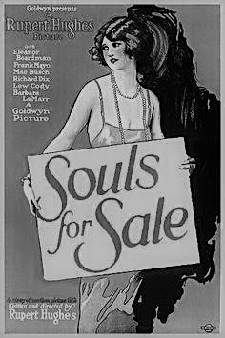 SOULS FOR SALE (1923)
SOULS FOR SALE (1923) (90 Min.) Genre: 1920 DRAMA, Transfer Quality: A
comedy-melodrama, based on the novel by Rupert Hughes (who also directed), blends fiction and reality to tell the story of a young woman's rise in Hollywood; the film uses real stars and productions (even Charles Chaplin filming The Gold Rush) as its backdrop. Eleanor Boardman plays Remember Steddon, better known as Mem. Mem is a small-town girl who marries slick bad guy Owen Scudder (Lew Cody); Owen insures his brides and then murders them for the money. After the wedding, Mem starts to have her doubts about him and runs away while their train is chugging through the desert. She happens on a film crew and gets work as an extra, later becoming a famous dramatic actress in Hollywood with the help of director Frank Claymore (Richard Dix). Scudder finally tracks her down during a shoot involving a circus tent; when a storm sets the tent on fire, Scudder loses his life saving Mem from a wind machine's propeller. Freed from her marriage, Mem is able to choose between Claymore and her leading man. Boardman, whose first starring role finds her surrounded by a long and impressive supporting cast, wound up at the Goldwyn studios through a "New Faces" contest. Her co-winner, future star William Haines, also had a bit part as the company's assistant director. — Janiss Garza
Starring: Eleanor Boardman, Mae Busch, Barbara La Marr, Richard Dix, Erich Von Stroheim | Directed by: Rupert Hughes
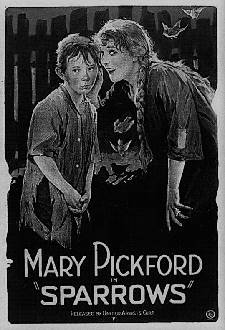 SPARROWS (1926)
SPARROWS (1926) (81 Min.) Genre: 1920 DRAMA, Transfer Quality: A
Sparrows, Mary Pickford's 1926 release, superbly combines the two elements—sentiment and adventure—that characterized Pickford's best work. At first glance, the film seems to be a horror picture, as satanic potato farmer Grimes (Gustav Von Seyfertitz) crushes a child's doll with his thumb and forefinger and tosses the plaything into the dismal swamps surrounding his lands. We learn that Grimes has been exploiting the children from a local orphanage, forcing them to work his farm day and night. Though collecting a hefty maintenance pay for the orphans, Grimes dresses them in rags and feeds them a starvation diet. Happily, Mary Pickford, the oldest of the orphans, has enough gumption to stand up to Grimes and prohibit him from inflicting any further atrocities. The plot thickens when a kidnaped child is left in Grimes' care in exchange for a generous portion of the ransom money. Mary rescues the abducted child, as well as all the other orphans, by leading them through the alligator-infested and quicksand-festooned swamp—a truly frightening sequence, made even more so by the use of real gators. Sparrows falters only in those scenes where Pickford, with genuine but somewhat misguided piety, "converses" with the Almighty, and in the final motorboat-chase sequence, which seems prolonged (and unnecessary!) after that heart-pounding swamp escape. — Hal Erickson
Starring: Mary Pickford, Gustav von Seyffertitz, Roy Stewart, Mary Louise Miller | Directed by: William Beaudine
 STREET ANGEL (1928)
STREET ANGEL (1928) (102 Min.) Genre: 1920 DRAMA, Transfer Quality: B
Fox's follow-up to Seventh Heaven, The Street Angel reunited stars Charles Farrell and Janet Gaynor with director Frank Borzage. The action begins in Naples, as poverty-stricken Maria (Gaynor) steals medicine for her ailing mother. Now a fugitive from justice, Maria escapes by joining a travelling carnival, where she meets and falls in love with portrait painter Angelo (Charles Farrell). Impressed by her ethereal beauty, Angelo asks the girl to pose for his portrait of the Madonna. But when she's suddenly arrested, the disillusioned Angelo sinks into depravation. Released from prison, Maria sees her portrait in a church and is inspired to seek out Angelo. Explaining the circumstances of her arrest, Maria saves Angelo from his sordid surroundings, inspiring him to return to painting — and, not surprisingly, to propose marriage. Heavily influenced by the "Germanic" style then in vogue, Street Angel lacked the simplicity and sincerity of Sunrise but managed to post a profit all the same.
Starring: Janet Gaynor, Charles Farrell, Natalie Kingston, Henry Armetta | Directed by: Frank Borzage
 SUNRISE (1927)
SUNRISE (1927) (110 Min.) Genre: 1920 DRAMA, Transfer Quality: A
Considered by many to be the finest silent film ever made by a Hollywood studio, F.W. Murnau's Sunrise represents the art of the wordless cinema at its zenith. Based on the Heinrich Sudermann novel A Trip to Tilsit, this "Song of Two Humans" takes place in a colorful farming community, where people from the city regularly take their weekend holidays. Local farmer George O'Brien, happily married to Janet Gaynor, falls under the seductive spell of Margaret Livingston, a temptress from The City. He callously ignores his wife and child and strips his farm of its wealth on behalf of Livingston, but even this fails to satisfy her. One foggy evening, O'Brien meets Livingston at their usual swampland trysting place. She bewitches him with stories about The City—its jazz, its bright lights, its erotic excitement. Thrilled at the prospect of running off with Livingston, O'Brien stops short: "What about my wife?" Drawing ever closer to her victim, Livingston murmurs "Couldn't she just....drown?" (the subtitle bearing these words then "melts" into nothingness). In his delirium, the husband agrees. The plan is to row Gaynor to the middle of the lake, then capsize the boat. Gaynor will drown, while O'Brien will save himself with some bulrushes that he'd previously hidden in the boat; thus, the murder will look like an accident. The next day, the brooding O'Brien begins slowly rowing his unsuspecting wife across the lake. — Hal Erickson
Starring: George O'Brien, Janet Gaynor, Margaret Livingston, Bodil Rosing | Directed by: F.W. Murnau
 TALE OF TWO WORLDS, A (1921)
TALE OF TWO WORLDS, A (1921) (70 Min.) Genre: 1920 DRAMA, Transfer Quality: B
This is one of a number of silent pictures in which a young American is raised as a Chinese girl, and even though she has no Asian features to speak of, she never guesses she's white until the film's end. While they are visiting China on business a curio collector, Carmichael (Dwight Crittenden) and his wife (Irene Rich), are killed during a Boxer uprising. A servant, Ah Wing (E. A. Warren), saves their baby, which he takes to America and raises as his own. Sui Sen (Leatrice Joy) grows up in Chinatown really believing that Ah Wing is her father. A wealthy American, Newcombe (J. Frank Glendon), sees Sui Sen and falls in love with her on the spot. But Ling Jo (Wallace Beery) — the same man responsible for the Carmichaels' deaths — is living in the very same Chinatown and is determined to make the girl his wife. Ah Wing tells Ling Jo that if he can get him the scepter of the Mings — a supposedly impossible task — then he can have Sui Sen. But Ling Jo comes through and Ah Wing has to honor the promise. Newcombe finds out about it, however, and goes to save Sui Sen. But he is captured and taken to the steel room to be crushed to death. With the help of a Chinese boy, Newcombe is able to escape, and Ling Jo winds up being crushed in the steel room instead. Finally Sui Sen learns that she is American as apple pie and weds Newcombe. This picture was the first time author Gouverneur Morris wrote a story directly for the screen, and it was part of producer Samuel Goldwyn's "Eminent Authors" series.
Starring: Leatrice Joy, Wallace Beery, Louie Cheung, Dwight T. Crittenden | Directed by: Frank Lloyd
 TEMPTRESS, THE (1926)
TEMPTRESS, THE (1926) (106 Min.) Genre: 1920 DRAMA, Transfer Quality: A
The Temptress was Greta Garbo's second American film, and while it may strike modern viewers as excessively melodramatic, Garbo is always worth watching. The star plays Elena, the wife of Monsieur Canterac (Lionel Barrymore) — and the mistress of rich Parisian banker Monsieur Fontenoy (Marc MacDermott). When the banker's Argentine friend Robledo (Antonio Moreno), a dynamic young engineer, pays a visit to Paris, the fickle Elena immediately falls in love with him. Upon learning that Fontenoy has lost his fortune, Elena dumps him and returns to her husband, whereupon the banker kills himself. Evidently not content with ruining one life, Elena heads to Argentina and goes to work on Robledo, leading to a bloody whip duel between Robledo and his rival Manos Duros (Roy D'Arcy). Inevitably, Elena drives Robledo to perdition and indirectly causes the destruction of the magnificent dam upon which he has worked all his life. Banished from Argentina, she returns to Paris, where she spends the rest of her days as a seedy streetwalker. At least, that was the ending of the European version of The Temptress. The American version incredibly ends happily, five years after the above-described events, as Robledo and the reformed Elena triumphantly supervise the opening of his now-repaired dam! Initially, the film's director was Garbo's mentor-lover, the brilliant Mauritz Stiller, but he was replaced halfway through by the competent but uninspired Fred Niblo — and the finished picture shows this division of interests all too clearly. — Hal Erickson
Starring: Greta Garbo, Antonio Moreno, Lionel Barrymore, Roy D'Arcy | Directed by: Fred Niblo, Mauritz Stiller
 THEIR OWN DESIRE (1929)
THEIR OWN DESIRE (1929) (65 Min.) Genre: 1920 DRAMA, Transfer Quality: A
Yet another early talkie about love, jealousy and divorce among the upper classes, Their Own Desire remains a dramatically stilted if technically efficient star vehicle. Lewis Stone is married to frumpy Belle Bennett, whom he leaves for the more streamlined Helene Millard. Stone's daughter, Norma Shearer, formerly a carefree member of the younger polo set, takes her mother's side on the issue and refuses any further association with the parent she once worshipped. In an attempt to forget her family problems, Shearer dallies with young Robert Montgomery and they fall madly in love. But he turns out to be Millard's son and Mother Bennett reacts to this alarming development by having fainting spells. Forced by circumstances to meet in secrecy, Shearer and Montgomery find themselves caught up in a ferocious storm on Lake Michigan and are reported missing. They have survived on an uninhabited island, however, from whence they are rescued by Stone, whom Shearer has forgiven. Parading a series of sleek gowns by Adrian, Norma Shearer performs one of her patented "restless debutante" roles with her usual elan but is somewhat defeated by Frances Marion's overly talkative scripts. Still, Their Own Desire did well enough at the box-office for MGM to re-team her with newcomer Robert Montgomery in the similar The Divorcee (1930), for which she earned an Academy Award.
Starring: Norma Shearer, Robert Montgomery, Belle Bennett, Helene Millard | Directed by: E. Mason Hopper
 TORRENT (1926)
TORRENT (1926) (68 Min.) Genre: 1920 DRAMA, Transfer Quality: A
The Vincent Blasco-Ibanez novel Entre Naranjos served as the inspiration for Greta Garbo's first American film, The Torrent. Garbo plays Leonora, a full-bodied Spanish peasant girl who falls in love with her landlord's son Don Rafael Bull (Ricardo Cortez). To prevent his son from marrying beneath his station, Don Rafael's father banishes Leonora from his property. She relocates in Paris, where she achieves fame and fortune as an opera singer, while back at home Don Rafael becomes a prominent politician. When Leonora returns home, she spurns his offers of marriage, even during a raging flood in which her life is in Don Rafael's hands. After this spectacular sequence, the film's surprisingly unhappy ending seems anticlimactic. Garbo's lover-mentor Mauritz Stiller had originally been slated to direct The Torrent, but at the last minute MGM opted for house director Monta Bell. Whether or not Stiller could have compensated for the script's more ludicrous passages is open to conjecture: Suffice to say that, without Garbo's presence, The Torrent would have been just so much Spanish applesauce. — Hal Erickson
Starring: Greta Garbo, Ricardo Cortez, Gertrude Olmstead, Edward Connelly | Directed by: Monta Bell
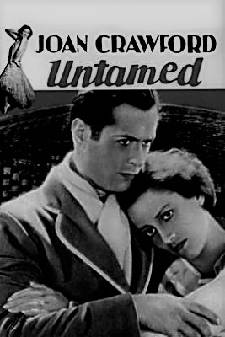 UNTAMED (1929)
UNTAMED (1929) (88 Min.) Genre: 1920 DRAMA, Transfer Quality: A
Untamed was touted by MGM as Joan Crawford's talking-picture debut, even though she'd already been heard as well as seen in Hollywood Revue of 1929. Best described as Somerset Maugham on toast, the film casts Crawford as Bingo, an oil heiress who has been raised in the tropics. When her rough-and-tumble guardians Murchison (Ernest Torrence) and Presley (Holmes Herbert) decide it is time to "civilize" the girl, they take her to New York, intending to indoctrinate her in the proper social graces. En route to Manhattan, Bingo falls in love with Andy (Robert Montgomery), whose lack of money and breeding means nothing to her. But when Andy finds out that Bingo is worth millions, he avoids her like the plague, refusing to live off the girl's riches. At her first high-society party, Bingo shocks the New York elite with her crude behavior, going so far as to punch out snooty debutante Marjory (Gwen Lee). Later on, Andy breaks Bingo's heart by again refusing to marry her and running off with Marjory. In desperation, Bingo grabs a gun and pumps Andy full of lead — which has the curious effect of convincing him that she'll make the perfect bride! Aside from Joan Crawford's scintillating performance, Untamed is difficult to swallow when seen today. — Hal Erickson
Starring: Joan Crawford, Robert Montgomery, Ernest Torrence, Holmes Herbert | Directed by: Jack Conway
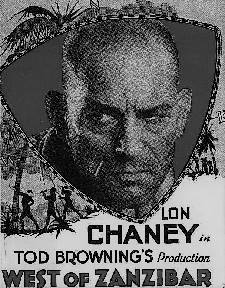 WEST OF ZANZIBAR (1928)
WEST OF ZANZIBAR (1928) (63 Min.) Genre: 1920 DRAMA, Transfer Quality: A
In this lurid Tod Browning melodrama, boasting a thoroughly creepy performance by Lon Chaney, Chaney plays Phroso, a limehouse magician who is thoroughly in love with his wife Anna (Jacquelin Gadsdon). Also in love with Phroso's wife is ivory-trader Crane (Lionel Barrymore). After a performance, Anna tells Phroso that she is leaving him to go away with Crane to Africa. After Phroso confronts Crane, Crane kicks him down a second-floor landing, crippling him. Months later, Phroso, now known as "Dead Legs" Flint, is now seen to be paralyzed from the chest down, and he gets around by pulling himself forward by his hands. He enters a church where he sees Annie has returned, but she is dead at the altar, leaving her child Maizie, whom Dead Legs assumes to be Crane's child, crying next to her. Hate consumes the soul of Dead Legs, and he swears vengeance on Crane. Years pass. Dead Legs is now lording it over a group of African savages as their god. Maizie (Mary Nolan) has been installed at a brothel in Zanzibar and is now a broken-down alcoholic prostitute. Dead Legs conspires to steal some of Crane's ivory so Crane can appear before Dead Legs, and his revenge can be redeemed. He sends for Maizie and reveals her to Crane. He plans on killing Crane and, due to an African tribal custom that says a man's daughter must be burned at the stake when he dies, have the savages have their way with Maizie. But when Crane arrives and he tells Dead Legs that Maizie is not his daughter but Dead Legs' daughter, Dead Legs is stupefied. Crane leaves and is shot by the savages, his body returned to Dead Legs. Now the bloodthirsty savages want Maizie, so that she can be sacrificed at the stake. Dead Legs, as her father, must now conspire a way to save his daughter from certain death. — Paul Brenner
Starring: Lon Chaney, Lionel Barrymore, Warner Baxter, Mary Nolan | Directed by: Tod Browning
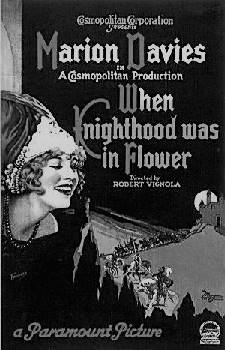 WHEN KNIGHTHOOD WAS IN FLOWER (1922)
WHEN KNIGHTHOOD WAS IN FLOWER (1922) (134 Min.) Genre: 1920 DRAMA, Transfer Quality: B
Film critics (at least those who weren't employed by the Hearst Corporation) frequently complained about the amount of money newspaper magnate and motion picture producer William Randolph Hearst spent on the pictures starring his companion Marion Davies. When it came to this historical adventure, they certainly had fodder to lambaste the film; it cost 1.5 million dollars, a real fortune in 1922 cash. But in spite of the over-inflated budget, critics had to admit that even at a lengthy 12 reels, this was solid entertainment — and Davies was good in it. The picture was based on the novel by Charles Major, and what it lacked in historical accuracy it certainly made up for in the sumptuous Joseph Urban sets. Mary Tudor (Davies), the younger sister of King Henry VIII (Lyn Harding), falls in love with commoner Charles Brandon (Forrest Stanley). There are other plans for Mary, however; she is supposed to make a politically strategic marriage to the elderly King Louis XII of France (William Norris). Brandon is framed for murder, but Mary, disguised as a boy, helps him to escape. Henry tracks down his sister and her lover at a Bristol Inn, and Mary agrees to wed the French king if Brandon's life is spared. After Brandon is exiled, Mary goes ahead with the wedding, but King Louis, in his attempt to prove he is lively enough for such a pretty young bride, drops dead. His nephew and heir to the throne, Francis (William Powell, in his first really important film role), wants to wed Mary, but Brandon comes to the rescue. When Henry discovers that his sister and Brandon have married, he remarks, "I should have consented in the first place, and saved us all this trouble." The Hearst machine used the film's great expense as a promotional device, and this won the criticism of one newspaper writer, who felt that Davies' talent stood on her own. Instead of being incensed, Hearst was pleased that Davies was so passionately supported, and he hired the reporter, Louella Parsons.
Starring: Lyn Harding, William Norris, Forrest Stanley, Pedro de Cordoba | Directed by: Robert Vignola
 WILD ORANGES (1924)
WILD ORANGES (1924) (66 Min.) Genre: 1920 DRAMA, Transfer Quality: A
It's a pity that there are apparently no longer any public copies available of this suspense drama by King Vidor because at the time of its release, its sophisticated approach to filmmaking impressed critics and fans alike. It takes place at a bay near the Georgia swamps, where John Woolfolk (Frank Mayo) lands in his yacht. After the death of his wife in an accident he had taken a cruise with just one friend, Paul Halvard (Ford Sterling). When Woolfolk goes ashore for water, he discovers old Lichfield Stope (Nigel de Brulier) and his granddaughter, Nellie (Virginia Valli), who are virtually being held prisoner by Iscah Nicholas, a half-crazed, half-childlike homicidal maniac (Charles A. Post). Woolfolk tries to help the girl, but when he comes back to shore, he finds that Nicholas has killed Stope and tied Nellie to a bed. Woolfolk fights the brute and takes Nellie to his yacht, but Nicholas follows after them. He shoots at the boat, injuring Halvard, and is finally killed by a mad dog that breaks its leash and attacks him.
Starring: Frank Mayo, Virginia Valli, Ford Sterling, Charles A. Post | Directed by: King Vidor
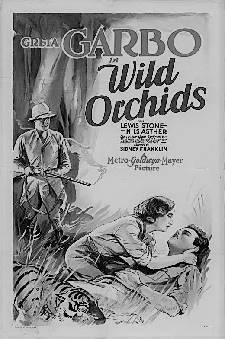 WILD ORCHIDS (1929)
WILD ORCHIDS (1929) (119 Min.) Genre: 1920 DRAMA, Transfer Quality: A
In this silent film, the beautiful Lili Sterling (Greta Garbo) meets up with the enchanting Prince de Gace (Nils Asther) while on a trip with her husband, John (Lewis Stone), and the two find themselves impossibly drawn to one another. However, when John begins to suspect his wife of infidelity, his jealousy could have deadly results. — Iotis Erlewine
Starring: Greta Garbo, Lewis Stone, Nils Asther | Directed by: Sidney A. Franklin
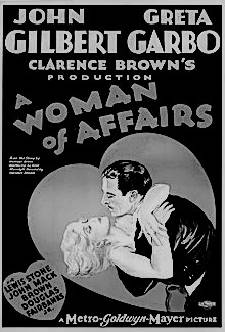 WOMAN OF AFFAIRS, A (1928)
WOMAN OF AFFAIRS, A (1928) (108 Min.) Genre: 1920 DRAMA, Transfer Quality: A
Michael Arlen's notorious novel The Green Hat was considered such a hot potato censor-wise that the property's title could not be used when it was adapted to film. Retitled A Woman of Affairs, this tale of a woman destroyed by syphilis was heavily laundered for the screen. Greta Garbo plays an impulsive British lass who, when denied permission to marry John Gilbert, hops from bed to bed with various partners. She marries a man who turns out to be a thief. When her husband commits suicide, Garbo is again wooed by Gilbert, who in the meantime has acquired a spouse of his own. Though she passionately loves Gilbert, Garbo sends him away, rather than ruin his life as she's ruined her own. With that classic enigmatic half-smile on her face, Garbo suicidally crashes her expensive automobile into the tree under which she sat with Gilbert the day he first declared his love for her. Outside of the always fascinating Greta Garbo, the best performance in Woman of Affairs is offered by Douglas Fairbanks Jr. as Garbo's drunken, dissipated younger brother. — Hal Erickson
Starring: Greta Garbo, John Gilbert, Lewis Stone, Douglas Fairbanks Jr. | Directed by: Clarence Brown





